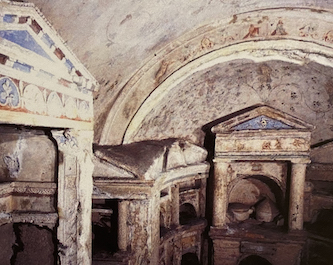- Hits: 446
 The rule forbidding burials within the urban settlement was strictly followed in Rome and in the roman world in general at least until the early Middle Ages: this resulted in the location of cemeteries outside the city walls and along the roads heading out of town, where the tombs lined up one afier the other with no interruption.
The rule forbidding burials within the urban settlement was strictly followed in Rome and in the roman world in general at least until the early Middle Ages: this resulted in the location of cemeteries outside the city walls and along the roads heading out of town, where the tombs lined up one afier the other with no interruption.
The choice of burial place and the type of tomb were basically determined by the financial means and the type ofmessage addressed to whomever would look at the tomb, as intended by the person the tomb was commissioned by.
Being located along the side of the road granted better visibility, and was therefore a sought afler feature by the deceased and his family.
Both burial and cremation had been in use ever since Rome s early times, with the latter prevailing beween the 3rd - 2nd century b.C. and the Ist century AD, whereas from mid imperial times (2nd century AD) ground burial becomes the only common practice.
Between the end of the Ist century b.C. and the Ist century AD, because of a prevalence in cremation, the so called columbari were widely spread: they were collective tombs for different family members, inchudingslaves andfreedmen, or for the members of a corporation. Thesetombs, called columbari as in a doves' (columbac) nest, were very practical for a highly populated city, as they could host a large mumber of burials thanks to their structure and interior subdivision.
There are examples of chamber tombs made of bricks, sometimesfenced, dating back to the lst century AD and including both type of burials: on their inner walls were small dugrecessesfor the terracotta urns, whereas on the ground and in the arcosolia were terracotta or marble crates.
This new kind of sepulchre, quite dierent from the monumentaltombs, will last unchallenged for the whole imperial age and late antiquity, when the architectural and spatial connection between funerary momuments and religious areas will start a new relation between cult location and burial space, as in the Christian tradition.





